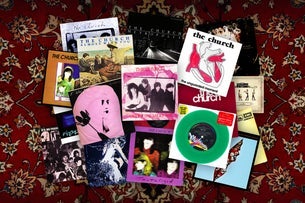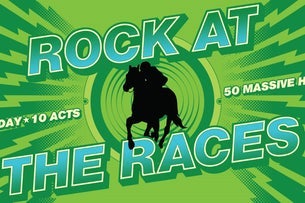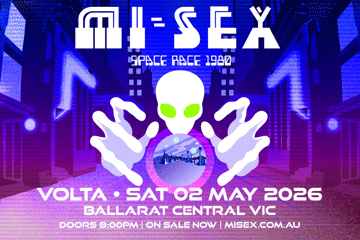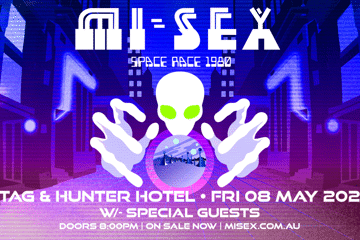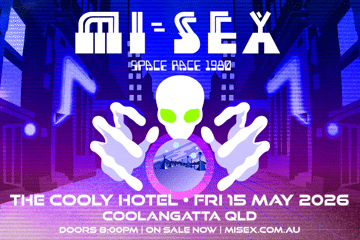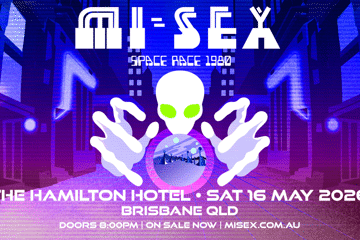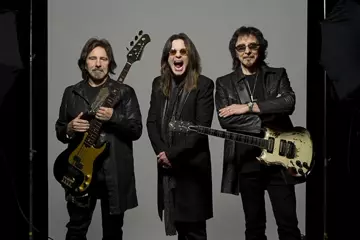 David Bowie
David Bowie2000 Light Years From Home – The Rolling Stones (1967)
“Bound for a star with fiery oceans/ It’s so very lonely…” If Mick Jagger needed inspiration to convey the isolation of outer space, he was in the right place – Brixton Jail in London.
He was squatting there after a police raid on Keith Richards’ home on February 12, 1967 found him with drugs. He was expecting a three month stay but was out the next day on bail. Pressure from the media saw all charges later dropped.
Recording began that July 1967 for their psychedelic blow-up Their Satanic Majesties Request, with Brian Jones’ mellotron and electric dulcimer and Richards’ guitar and fuzz bass creating the right mood for lines as “Freezing red deserts turn to dark.”
Mars Needs Guitars – Hoodoo Gurus (1985)
The title track of their Mars Needs Guitars album stemmed from guitarist Dave Faulkner’s fascination with science fiction and the mysteries of outer space. Written by all the members, there is also a message that if music can bridge the gap between earthlings, it could also do so with all intelligent life forms.
January 28, 1986 – Owl City (2011)
Don't miss a beat with our FREE daily newsletter
A warning to Trumpy, the date alludes to the space shuttle Challenger disaster. The track loops President Ronald Reagan’s speech over a choir multi-dubbed by songwriter Adam Young, and a sample of Port Blue's Helmet that is reversed and slowed.
Mr. Spaceman – The Byrds (1966)
The track that the rock press coining the term “space rock” in the ‘60s, this came in the middle of conspiracy theories about UFOs. Leader Roger McGuinn (then calling himself Jim) started this as a sci-fi movie script. It changed it to a ditty where he reaches out to aliens entering his house at night asking if he would go back with them.
The affable bug-eyes leave a message on his window in toothpaste that they will visit next time they land on earth. McGuinn hoped the country-rock flavoured song played on radio would reach the ears of the xanders out there.
Meantime, The Byrds’ manager claimed he’d taken out a US$1,000 insurance policy ($296,917.54 in today’s money) with Lloyd’s of London against his clients being kidnapped by extraterrestrial joy-riders.
Subterranean Homesick Alien – Radiohead (1997)
The first essay that UFO abduction believer Thom Yorke wrote in school was “You are an alien from another planet. You have landed, and you are standing in the middle of Oxford, and write an essay about what you see if you're an alien form another planet, how would you see these people?”
In the song, it’s the humans who are the weird looking ones. Yorke believes the aliens are out there filming us walking in the streets. He describes them as “Little green creatures with incredible large brains and big, beautiful, black eyes”.
Musically, they went for the adventurous jazz fusion sounds of Miles Davis' ground breaking mid-70s album Bitches Brew using synths and guitars.
Space Race – Mi-Sex (1980)
Mi-Sex arrived in Sydney from New Zealand in the 1978 just as New Wave hit in all its flamboyance and futuristic soundwaves. A great live act, they adapted the image to songs about computer dating, “carbon copy people” and space travel.
Astronomy Domine – Pink Floyd (1967)
The opening track of Pink Floyd’s debut album The Piper At The Gates Of Dawn, in the midst of altered chemical states, Astronomy Domine was an early guide to the brilliance of its writer and singer Syd Barrett.
This was before he took one too many LSD tabs and went off into an outer space of his own making.
Inspired by the Cold War space duel between the US and USSR, the red planet gets a mention with the line “Mars is in conjunction with a fixed star”. There’s another link. Syd’s guitar is inspired by the brass motif from Mars, The Bringer Of War in English composer Gustav Holst's seven-part The Planets written between 1914 and 1917. Other planets and their moons as Oberon, Miranda, Titania and Titan are mentioned.
The original title of the track was Astronomy Dominé (An Astral Chant). Dominé, vocative of Dominus, which is Latin for "Oh Lord which is used in Gregorian chants. A great deal of Floyd freaks spent a lot of time investigating that link. They also spent much energy trying to decipher the morse code on the track, giving up when the penny clanged it was just a random choice of dots and dashes.
Under The Milky Way – The Church (1988)
It was a spectacular view from the deck of Steve Kilbey’s mum’s home in the NSW Mid-Coast village of Smiths Lake/ Worimi that set things in motion. It was a starry starry sky and, below, phosphorescent reflections in the lagoon.
After dinner, Kilbey rolled a joint, and went to the cabin in the backyard and started composing on the out-of-tune piano. His partner at the time, Karin Jansson, joined him, and they started throwing lyrical ideas around.
As Kilbey said later, “It didn't specifically mean anything”. The line “Sometimes when this place gets kind of empty/ Sound of their breath fades with the light”, for instance, is about a gig at Amsterdam’s music venue Melkweg (Dutch for “Milky Way”) where hashish is smoked openly.
The way the lyrics, unorthodox chords, Kilbey’s resigned vocal and the gorgeous melody melted together to create a melancholy mood of travelling through the sky alone.
Interstellar Love – The Avalanches (2020)
In 1977 when the two Voyager spacecraft launched to study the outer platforms, astrologist physicist Carl Sagan and writer Ann Druyan were part of a committee set up to choose a collection of songs, sounds and images to represent Planet Earth.
One of Druyan’s choice of sounds was her own heartbeat. The pair fell in love, and the day before she recorded it, he proposed marriage. The resultant sound was a person in love floating through space.
Melbourne band The Avalanches thought it a cool tale, and recorded a song about it, joined by Texas soul singer Leon Bridges, and banging on a sample of English studio band Alan Parsons Project’s hit Eye In The Sky. Druyan allowed them to use her photo on the cover artwork of the track’s parent album We Will Always Love You.
We're Not In Orbit Yet...— Broken Bells (2022)
Broken Bells aka space age enthusiasts James Mercer of The Shins and producer Danger Mouse anticipated a romance in a rocket trip. They declare, "It's the wrong time to decelerate / We're not in orbit yet."
That they’ve got a foot in each planet, they combine earthly folk sounds with spooky synth sounds.
Hand To Earth – Australian Art Orchestra (2001)
The intriguing track was created during the Australian Art Orchestra’s residency in the remote highlands of Tasmania, and a collaboration with Yolŋu songman, Daniel Yipininy Wilfred and Korean vocalist Sunny Kim.
Working on the premise that the challenges of the 21st century are solved in the stories of the 40,000+ year-old oral tradition from South East Arnhem Land, among the many elements used on Hand To Earth are First Nations notions of astrology.
Space Oddity – David Bowie (1969)
David Bowie didn’t write this about the Apollo 11 moon landing, an event considered so significant that Australian school students were sent home to watch it on TV.
A number of incidents in Bowie’s life a around that time also provided inspiration. One was Stanley Kubrick movie 2001: A Space Odyssey which he saw a couple of times when very stoned. “The passage trip really freaked me out.”
He had also broken up with dancer Hermione Farthingale and feeling lonely and alienated. Hence the creation of the fictional astronaut character of Major Tom who is lost in space after cutting communication with Earth. The BBC in England extensively used the Bowie song in its coverage of the moon landings, never realising that the astronaut never came back.
Such was the cultural impact of Space Oddity, that a number of sequels followed. One was by Bowie himself, in Ashes To Ashes (1980) where Major Tom makes contact but rebuffed because Ground Control thinks he’s a junkie.
A 1983 techno track by Germany’s Peter Schilling, Major Tom (I'm Coming Home), reached a higher chart position than Bowie’s in the US. K.I.A.’s Mrs. Major Tom looks at the incident through the eyes of his wife.




